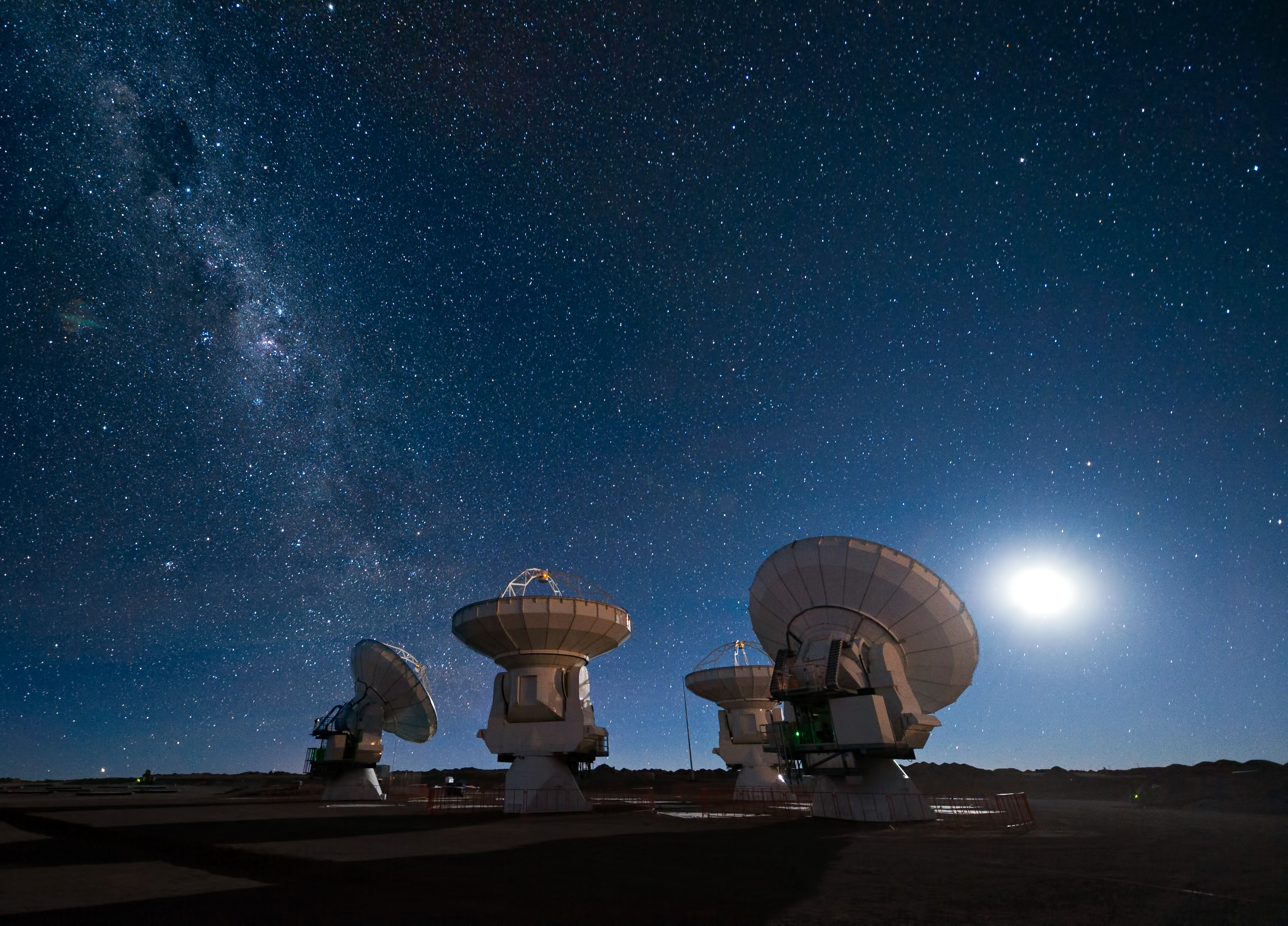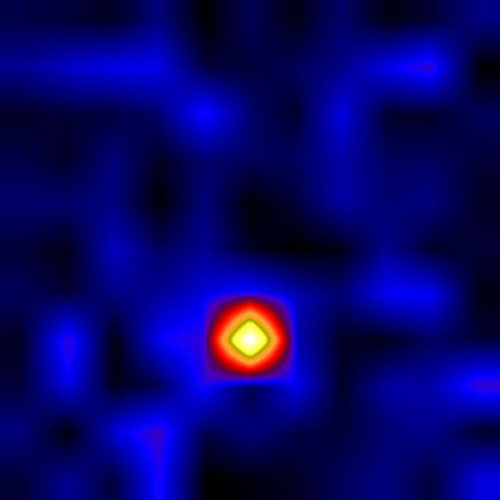|
Green Bank Interferometer
The Green Bank Interferometer (GBI) is a former radio astronomy telescope located at Green Bank, West Virginia (USA) and operated by the National Radio Astronomy Observatory (NRAO). It included three on-site radio telescopes of 85-foot (26m) diameter, designated 85-1, 85-3, and 85-2 (85-1 is also known as the Tatel Telescope) and a portable telescope. History The first telescope (85-1, Tatel) was built in 1959 at a fixed location. It was used in Project Ozma in 1960 without Interferometer. In 1963, in anticipation of adding movable telescopes for interferometer, the second telescope kit identical to 85-1 was ordered. The construction of the second telescope (85-2) was completed in 1964 along with a track from 85-1. At that time, the 85-2 telescope was placed at the end of the track and cables were connected between the two telescopes. The GBI began operation that year as a two element interferometer in order to test large aperture synthesis arrays and study radio astrometry a ... [...More Info...] [...Related Items...] OR: [Wikipedia] [Google] [Baidu] |
Radio Astronomy
Radio astronomy is a subfield of astronomy that studies celestial objects at radio frequencies. The first detection of radio waves from an astronomical object was in 1933, when Karl Jansky at Bell Telephone Laboratories reported radiation coming from the Milky Way. Subsequent observations have identified a number of different sources of radio emission. These include stars and galaxies, as well as entirely new classes of objects, such as radio galaxies, quasars, pulsars, and masers. The discovery of the cosmic microwave background radiation, regarded as evidence for the Big Bang theory, was made through radio astronomy. Radio astronomy is conducted using large radio antennas referred to as radio telescopes, that are either used singularly, or with multiple linked telescopes utilizing the techniques of radio interferometry and aperture synthesis. The use of interferometry allows radio astronomy to achieve high angular resolution, as the resolving power of an interferometer is set ... [...More Info...] [...Related Items...] OR: [Wikipedia] [Google] [Baidu] |
United States Naval Research Laboratory
The United States Naval Research Laboratory (NRL) is the corporate research laboratory for the United States Navy and the United States Marine Corps. It was founded in 1923 and conducts basic scientific research, applied research, technological development and prototyping. The laboratory's specialties include plasma physics, space physics, materials science, and tactical electronic warfare. NRL is one of the first US government scientific R&D laboratories, having opened in 1923 at the instigation of Thomas Edison, and is currently under the Office of Naval Research. As of 2016, NRL was a United States Navy Working Capital Fund, Navy Working Capital Fund activity, which means it is not a line-item in the US Federal Budget. Instead of direct funding from Congress, all costs, including overhead, were recovered through sponsor-funded research projects. NRL's research expenditures were approximately $1 billion per year. Research The Naval Research Laboratory conducts a wide v ... [...More Info...] [...Related Items...] OR: [Wikipedia] [Google] [Baidu] |
List Of Radio Telescopes
This is a list of radio telescopes – over one hundred – that are or have been used for radio astronomy. The list includes both single dishes and interferometric arrays. The list is sorted by region, then by name; unnamed telescopes are in reverse size order at the end of the list. The first radio telescope was invented in 1932, when Karl Jansky at Bell Telephone Laboratories observed radiation coming from the Milky Way. Africa Antarctica Asia Australia Europe North America South America Arctic Ocean Atlantic Ocean Indian Ocean Pacific Ocean Space-based Under construction or planned construction Proposed telescopes Gallery of big dishes File:FastTelescope*8sep2015.jpg, alt=Five hundred meter Aperture Spherical Telescope under construction, The 500 meter Five hundred meter Aperture Spherical Telescope (FAST), under construction, China (2016) File:GBT.png, alt=Green Bank Telescope, The 100 meter Green Bank Telescope, ... [...More Info...] [...Related Items...] OR: [Wikipedia] [Google] [Baidu] |
LS I +61 303
LS I +61 303 is a microquasar, a binary system containing a massive star and a compact object. The compact object is a pulsar and the system is around 7,000 light-years away. Discovery LS I +61 303 is an 11th-magnitude star that was recognised as a luminous object and catalogued as an OB star in 1959. It was included in the Hipparcos survey as HIP 12469 and had its parallax measured at milliarcseconds (mas), revised to − mas in the new reduction. The first ''Gaia'' data release gave a parallax of mas. The galactic radio source GT 0236+610 was found at the same position as LS I +61 303. A gamma-ray source 2CG 135+01 was found within a degree of its position, and the MAGIC telescope confirmed that LS I +61 303 was the source of the gamma rays. Periodic X-ray outbursts also occur. Binary system LS I +61 303 shows the spectrum of a Be star, a B0 main sequence star with disk that produces emission lines in its spectrum. Variations in its radial velocity show that it is i ... [...More Info...] [...Related Items...] OR: [Wikipedia] [Google] [Baidu] |
SS 433
SS 433 is one of the most exotic star systems observed. It is located in the Milky Way galaxy, and is an eclipsing X-ray binary system, with the primary being a stellar-mass black hole. The spectrum of the secondary companion star suggests that it is a late A-type star. SS 433 is the first discovered microquasar. It is at the centre of the supernova remnant W50. SS 433's designation comes from the initials of two astronomers at Case Western Reserve University: Nicholas Sanduleak and Charles Bruce Stephenson. It was the 433rd entry in their 1977 catalog of stars with strong emission lines.SS 433 David Darling, entry in ''The Internet Encyclopedia of Science'', accessed on line September 14, 2007. Its emission lines were studied by |
Cyg X-1
Cygnus X-1 (abbreviated Cyg X-1) is a galactic X-ray source in the constellation Cygnus and was the first such source widely accepted to be a black hole. It was discovered in 1964 during a rocket flight and is one of the strongest X-ray sources detectable from Earth, producing a peak X-ray flux density of (). It remains among the most studied astronomical objects in its class. The compact object is now estimated to have a mass about 21.2 times the mass of the Sun and has been shown to be too small to be any known kind of normal star or other likely object besides a black hole. If so, the radius of its event horizon has "as upper bound to the linear dimension of the source region" of occasional X-ray bursts lasting only for about 1 ms. Cygnus X-1 belongs to a high-mass X-ray binary system, located about 2.22 kiloparsecs from the Sun, that includes a blue supergiant variable star designated HDE 226868, which it orbits at about 0.2 A ... [...More Info...] [...Related Items...] OR: [Wikipedia] [Google] [Baidu] |
Cygnus X-3
Cygnus X-3 is a high-mass X-ray binary ( HMXB), one of the stronger binary X-ray sources in the sky. It is often considered to be a microquasar, and it is believed to be a compact object in a binary system which is pulling in a stream of gas from an ordinary star companion. It is one of only two known HMXBs containing a Wolf-Rayet star. It is invisible visually, but can be observed at radio, infrared, X-ray, and gamma-ray wavelengths. Observations Cygnus X-3 is a prominent X-ray source, with soft and hard X-rays both varying in intensity. Periods where the hard X-rays are at minimum intensity are known as soft states. It is less than half a degree from a gamma-ray pulsar, but is itself a weak gamma-ray source. It also shows periodic gamma-ray flares, apparently all occurring during the soft state. It is undetectable at visual wavelengths due to extreme extinction in the galactic plane. However, there is an infrared point source at its position. Cygnus&n ... [...More Info...] [...Related Items...] OR: [Wikipedia] [Google] [Baidu] |
GRO J1655-40
GRO J1655-40 is a binary star consisting of an evolved F-type primary star and a massive, unseen companion, which orbit each other once every 2.6 days in the constellation of Scorpius. Gas from the surface of the visible star is accreted onto the dark companion, which appears to be a stellar black hole with several times the mass of the Sun. The optical companion of this low-mass X-ray binary is a subgiant F star. Along with GRS 1915+105, GRO J1655-40 is one of at least two galactic "microquasars" that may provide a link between the supermassive black holes generally believed to power extragalactic quasars and more local accreting black hole systems. In particular, both display the radio jets characteristic of many active galactic nuclei. The distance from the Solar System is probably about 11,000 light years, or approximately half-way from the Sun to the Galactic Center, but a closer distance of ~2800 ly is not ruled out. GRO J1655-40 and its companion are mov ... [...More Info...] [...Related Items...] OR: [Wikipedia] [Google] [Baidu] |
GRS 1915+105
GRS 1915+105 or V1487 Aquilae is an X-ray binary star system which features a regular star and a black hole. It was discovered on August 15, 1992 by the WATCH all-sky monitor aboard Granat. "GRS" stands for "GRANAT source", "1915" is the right ascension (19 hours and 15 minutes) and "105" reflects the approximate declination (10 degrees and 56 arcminutes). The near-infrared counterpart was confirmed by spectroscopic observations. The binary system lies 11,000 parsecs away in Aquila. GRS 1915+105 is the heaviest of the stellar black holes so far known in the Milky Way Galaxy, with 10 to 18 times the mass of the Sun. It is also a microquasar, and it appears that the black hole rotates at least 950 times per second, close to the maximum of 1,150 times per second, with a spin parameter value between 0.82 and 1.00 (maximum possible value). Galactic superluminal source In 1994, GRS 1915+105 became the first known galactic source that ejects material with apparent superlum ... [...More Info...] [...Related Items...] OR: [Wikipedia] [Google] [Baidu] |
Active Galactic Nucleus
An active galactic nucleus (AGN) is a compact region at the center of a galaxy that has a much-higher-than-normal luminosity over at least some portion of the electromagnetic spectrum with characteristics indicating that the luminosity is not produced by stars. Such excess non-stellar emission has been observed in the radio, microwave, infrared, optical, ultra-violet, X-ray and gamma ray wavebands. A galaxy hosting an AGN is called an "active galaxy". The non-stellar radiation from an AGN is theorized to result from the accretion of matter by a supermassive black hole at the center of its host galaxy. Active galactic nuclei are the most luminous persistent sources of electromagnetic radiation in the universe, and as such can be used as a means of discovering distant objects; their evolution as a function of cosmic time also puts constraints on models of the cosmos. The observed characteristics of an AGN depend on several properties such as the mass of the central black hole, ... [...More Info...] [...Related Items...] OR: [Wikipedia] [Google] [Baidu] |
X-ray Binaries
X-ray binaries are a class of binary stars that are luminous in X-rays. The X-rays are produced by matter falling from one component, called the ''donor'' (usually a relatively normal star), to the other component, called the ''accretor'', which is very compact: a neutron star or black hole. The infalling matter releases gravitational potential energy, up to several tenths of its rest mass, as X-rays. (Hydrogen fusion releases only about 0.7 percent of rest mass.) The lifetime and the mass-transfer rate in an X-ray binary depends on the evolutionary status of the donor star, the mass ratio between the stellar components, and their orbital separation. An estimated 1041 positrons escape per second from a typical low-mass X-ray binary. Classification X-ray binaries are further subdivided into several (sometimes overlapping) subclasses, that perhaps reflect the underlying physics better. Note that the classification by mass (high, intermediate, low) refers to the optically vi ... [...More Info...] [...Related Items...] OR: [Wikipedia] [Google] [Baidu] |
Transient Astronomical Event
The asterisk ( ), from Late Latin , from Ancient Greek , ''asteriskos'', "little star", is a typographical symbol. It is so called because it resembles a conventional image of a heraldic star. Computer scientists and mathematicians often vocalize it as star (as, for example, in ''the A* search algorithm'' or ''C*-algebra''). In English, an asterisk is usually five- or six-pointed in sans-serif typefaces, six-pointed in serif typefaces, and six- or eight-pointed when handwritten. Its most common use is to call out a footnote. It is also often used to censor offensive words. In computer science, the asterisk is commonly used as a wildcard character, or to denote pointers, repetition, or multiplication. History The asterisk has already been used as a symbol in ice age cave paintings. There is also a two thousand-year-old character used by Aristarchus of Samothrace called the , , which he used when proofreading Homeric poetry to mark lines that were duplicated. Origen is kno ... [...More Info...] [...Related Items...] OR: [Wikipedia] [Google] [Baidu] |










